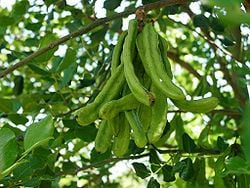Locust Bean Gum: Ancient History Meets Modern Gastronomy
- By Jillian Mead
- August 03, 2013
If youve ever read the ingredients label on a container of yogurt, ice cream, or cream cheese, you may have wondered what, exactly, is something named after a swarming insect doing in there? Rest assured, there arent any bug bits in your dairy fix.
Locust bean gum, AKA carob bean gum, is an all-natural food additive derived from the locust bean tree, prevalent in the Mediterranean region. The seed pods of the tree are separated into pulp and seed, and the gum is derived from the split, milled seeds, while carob powder, with a sweet flavor somewhat similar to chocolate, is produced from the pods (the tree is also known as the carob tree).

Often referred to as LBG for short, locust bean gum falls into the category of hydrocolloids, or things that help water molecules stick together. Hence it is used as a thickening and gelling agent in food production, and its commonly found in salad dressings, sauces, meat products, breads, and breakfast cereals as well as dairy products. Generally, food gums such as locust bean gum, xanthan gum, and guar gum make something chewier or thicker. Excellent for freeze/thaw applications, locust bean gum is invaluable for frozen dairy preparations. It can help stabilize foods by preventing sugar or ice from crystallizing, without adding additional fat or calories. This makes it an ideal ingredient to create light foods like reduced-fat desserts or creamy sauces that still taste satisfying.
Because of its pervasive use in the industrialized world, one may think that locust bean gum powder is a recent discovery, but in fact archaeological records show that carob trees grew in Israel in 4000 B.C., and the locust bean was recorded in the writings of Theophratus in 4 B.C. Sometimes referred to as the Egyptian fig, locust bean gum was even used to prepare bodies for mummification, and remnants of locust beans have been discovered in ancient Egyptian tombs as well as in Pompeii from circa 79 A.D.
Today, government programs utilize locust bean trees for their ecological benefit: the trees aid soil and water conservation efforts, as well as help provide shade to keep farm animals cool.
This simple ingredient can allow you to create gelified versions of flavorful liquids, like fruit or vegetable purees, and enhance the texture of a multitude of menu items from imaginative condiments to ultra-creamy puddings.

